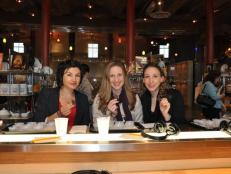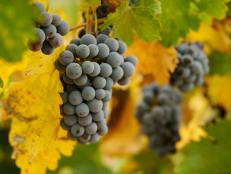4 Things You Learn in an Italian Cooking Class
If you’ve ever daydreamed that you were Julia Child in the movie Julie & Julia, dreamed of tasting your way through life as Johnny Depp in Chocolat, or ever wanted to cook in a professional kitchen in Italy, well, today your dream has come true. Say hello to Cooking Classes in Rome where you can learn traditional Italian cooking in one day and it won’t bust your travel budget!

Getty Images
On a recent trip to Rome, I spent five hours in the Trastevere neighborhood with 11 other travelers from the Unites States and New Zealand. We learned how to prepare four Italian courses and two sides. The food was beyond amazing: homemade pasta that tasted like warm butter cake, melting in your mouth (You’ll never look at store-bought pasta the same way) and stuffed chicken with pancetta, provolone, spinach and Italian sausage, just to name two. The five-hour class was life-changing and frankly, not long enough. But I took what I could get.
1: Rome has a Rich, Historic Cuisine
The cooking class came with a fascinating history lesson in Roman cuisine as well. Apparently, traditional Roman cuisine was heavily practiced in the Trastevere district. Trastevere is located on the west side of the Tiber River. As the story unfolded, we learned that the elite/high-class lived on the east side of the Tiber River, where you have all of the ancient ruins and most popular tourist attractions including the Colosseum, Piazza di Navona, Campo di Fiori, Borghese Gardens and the grand Spanish steps.
Related: Rome’s Must-Do List
All of the help and cooks for the elite, lived on the west side of the Tiber River in Trastevere, preparing the elites' meals every single day. Depending on who you ask, some might say that the best restaurants in Rome, are found west of the Tiber River, including Cacio de Pepe known for its the popular cacio de pepe (pasta with parmesan and pepper) and spaghetti alla carbonara made with egg and not red pasta sauce, which you can find at any restaurant in the city. Now, whether or not the above history lesson is in fact 100 percent true, still remains to be explored, but it served as a great aperitivo (appetizer in Italian) to our cooking adventure.
Our task was to prepare four courses with assistance from Chef Andrea, who runs Cooking Classes of Rome with his wife. Going into the class, nobody knew what to expect in terms of how hands-on or not chef would be. Chef Andrea provided guidance, showing us one-time how to cut, peel, fold and knead, and then it was our turn. The four courses that would define our day were eggplant parmigiana, spaghetti alla carbonara, chicken rolle’ stuffed with smoked provolone, spinach, pancetta (optional) and sausage (optional), and for dessert a divine lemon custard with peaches poached in rum). There were two additional side dishes as well: broccoletti (broccoli rabe) ripassati (twice cooked broccoli rabe) and roasted potatoes with rosemary.
2: Deboning Chicken: Not For the Faint of Heart

One of the most intricate lessons of the day was learning how to debone the leg and thigh of the chicken. With enough meat left over, it creates a perfect wrap for the ingredients. Something worth noting about the chicken rolle’ dish:
*If you’re not a fan of cutting chicken, getting your hands "dirty" and/or using a knife, then have your local butcher do you a huge favor and debone the chicken for you.

*Be kind to the chicken. Once you break the breast bone in half (with your hands), take an extremely sharp knife and go around the leg and thigh bone, carefully, removing the chicken. If you butcher the meat too much, it won’t wrap properly around your ingredients. Take it from someone who knows. I had to wrap and then re-wrap my chicken several times because I chopped a little too much.
*The twine wrapped around the chicken assisted in keeping the meat and its ingredients together while the bird was sautéed until brown and then baked, to finish off the cooking process.
3: Pasta Making Is a Sport!

In addition to the necessary flour and eggs, a great deal of kneading is a prerequisite for perfect Italian pasta. Here are your important steps:
*Arm and back stretches
*Generous amount of flour (per your favorite recipe instructions)
*Eggs. Lots of eggs (7)
*Strong hands to scramble those eggs!
*As you scramble, bring in the flour (a little at a time) making sure to maintain a good "flour-wall-defense."

The beauty of the pasta-making process isn't just in the intense scramble and kneading of the dough, but it’s in the rolling of the pasta dough onto the classic Eppicotispai chitarra (pronounced key-tahr-rah; pictured) pasta cutter that creates your spaghetti. Once the dough is rolled out onto the Eppicotispai chitarra, simply take one finger and strum the "guitar" strings and watch the pasta fall. Voila!
4: Eggplant Lovers Unite

Eggplant has to be on the hardest items to cook, simply because if not prepared correctly, it’s easily an incredibly mushy dish. Who wants that? Chef Andrea taught the class how to prepare an exceptional eggplant dish that was anti-mush. Something’s to note:
*Make sure to slice the eggplant not too thin and not too thick.
*Deep fry on very high heat. Using a wire basket is extremely helpful, so the eggplant can drain once you’re done frying.

*Let the eggplant breathe. Don’t stack on top of each other. They like their space.
The finished product will inevitably be something that’s quite yummy, nutritious and delicious.
When everything was complete, the class sat down and Chef Andrea graciously served us. Sitting at the front dining area of the cooking school, we were happily served with the dishes we had prepared throughout the day. At a small additional fee, we could enjoy our meal with a glass of wine. What’s Italian eating without fine wine? Last but certainly not least, one week after the class, we received detailed recipes for cooking all four courses at home! Thank you, Chef Andrea.












